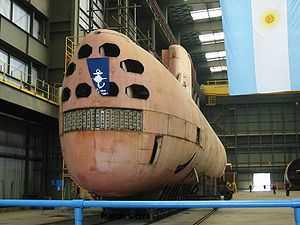ARA San Luis (S-32)
 Type 209 submarine ARA San Luis (S-32) at Domeq Garcia Shipyard | |
| Career | |
|---|---|
| Class and type: | Type 209 |
| Name: | San Luis |
| Builder: | Howaldtswerke-Deutsche Werft, Germany |
| Completed: | 3 April 1973 |
| Commissioned: | 24 May 1974 |
| Out of service: | 23 April 1997 |
| Fate: |
|
| General characteristics | |
| Class and type: | Salta-class submarine |
| Type: | Submarine |
| Displacement: | 1000 tonnes (Surfaced) 1285 tonnes (Submerged) |
| Length: | 55.91 m (183.4 ft) |
| Beam: | 6.2 m (20 ft) |
| Draught: | 5.5 m (18 ft) |
| Propulsion: | Diesel-electric, 4 diesels, 1 shaft |
| Speed: | 11 knots (20 km/h; 13 mph) Surfaced 21.5 knots Submerged |
| Range: | 11,000 nmi (20,000 km; 13,000 mi) (20,000 km) at 10 knots (20 km/h) surfaced (22,000 km at 15 km/h) |
| Endurance: | 50 days |
| Crew: | 31 |
| Sensors and processing systems: | Passive Sonar AN-525 A6 Active Sonar AN-407 A9 |
| Armament: | 8 × 533 mm torpedo tubes 22 torpedoes |
The ARA San Luis (S-32) is a Type 209 diesel-powered submarine of the Argentine Navy. Built in Germany, San Luis has a displacement of 1,285 tonnes and was introduced to the ARA in 1978. She was struck in 1997 after an incomplete overhaul.
History
San Luis is best known for serving in the Falklands War (Spanish: Guerra de las Malvinas/Guerra del Atlántico Sur) of 1982. Only one other submarine, the Second World War-era ARA Santa Fe was operational at this time. After Santa Fe was captured and scuttled by the British in South Georgia on April 28, and the nuclear submarine HMS Conqueror had sunk ARA General Belgrano on May 2, the Argentine fleet retired to port for the duration of the war, with the exception of San Luis, making her the only Argentine naval presence facing the British fleet. San Luis was a major concern for the British as she presented a serious danger.
San Luis reported two attacks on Royal Navy ships during the war. On May 1, HMS Brilliant and Yarmouth were sent to hunt down the San Luis operating north of Stanley. San Luis reported firing a German-made SST-4 torpedo which presumably missed its target.
San Luis attacked again on the night of May 10. Alacrity had made passage up Falkland Sound, sinking an Argentine merchant navy ship on the way. As Alacrity left the channel before dawn, sister ship Arrow was waiting to accompany her back to the Task Force. San Luis detected the two ships and fired two SST-4 torpedoes, one of which did not leave its tube; the other was apparently defeated by Arrow 's anti-torpedo measures.[1] There were several problems with torpedoes and torpedo systems; in particular it appears that the torpedoes were not prepared properly, and did not arm themselves after firing, so would not explode even if they did hit a target. It has been suggested that previous apparent misses could have been due to torpedoes which struck but did not explode.[1] After the Falklands War ended, German and Dutch engineers were sent to Argentina to discover what went wrong with their torpedoes. The problem was so simple as to be unbelievable: one of the Argentine sailors who was in charge of periodic maintenance of the torpedoes had inadvertently reversed the polarity of power cables between the torpedoes and the submarine. This meant that when the torpedoes' gyros were spun up, they ran "backwards" and thus tumbled on launch, preventing the weapons from taking up their proper heading.[2][3]
The mere existence and presence of San Luis was a severe nuisance to the task force. The threat posed by the San Luis forced the Royal Navy to suspend the rescue efforts of two Sea King helicopters who ditched at sea on 12 May and 18 May 1982 respectively, while conducting anti-submarine operations. Both aircraft were eventually scuttled by naval gunfire.[4][5]
San Luis returned to Puerto Belgrano on May 17 for repairs to her weapons systems, and was not operational for the rest of the war.
See also
References
- (Spanish) La Nacion newspaper: La guerra que no se vió (Spanish)
- ↑ 1.0 1.1 Harper, Lt Cdr Steven R. U.S. Navy (17 June 1994), Submarine Operations during the Falklands War (Paper), Newport: Naval War College
- ↑ Schmidt, LT Wade H., "Top Torpedo", Proceedings (U.S. Naval Institute) (March 1993)
- ↑ Haggart, James A. Lieutenant Commander U.S. Navy (1 May 1984), The Falkland Islands Conflict, 1982: Air Defense Of The Fleet (Paper), Marine Corps Command and Staff College via globalsecurity.org
- ↑ UK Military Aircraft Losses - 1982 Wolverhampton Aviation Group
- ↑ Howard, L. Burrow, M and Myall, E. (2011). Fleet Air Arm Helicopters since 1943. Staplefield, p. 239. ISBN 978-0-85130-304-8